Exporting and Printing the Library Components in a Dashboard
Library components visible in the page panel can be exported and printed, for example, library components that were created using Logi Report Designer and inserted into dashboards via the Resources panel.
When you export or print the library components in a dashboard, you choose whether to use system layout or customize the layout by yourself. In the system layout, Logi Report will calculate the positions of the library components in the dashboard following defined rule. If you are not satisfied with the system layout, you can customize the layout by yourself to determine the position of each library component and specify whether to export or print all the data of a table/crosstab or just the current page of the table/crosstab displayed in the dashboard. The customized layout can be saved for all users who can access the dashboard.
Select the following links to view the topics:
Exporting the Library Components
To export the library components in a dashboard, select the Export button  on the toolbar, or select the Options button
on the toolbar, or select the Options button  on the toolbar and select Export from the option list to open the Export dialog box, then:
on the toolbar and select Export from the option list to open the Export dialog box, then:
Exporting Using the System Layout
To export using system layout:
- In the Export dialog box, the System Layout item is selected as the layout by default.
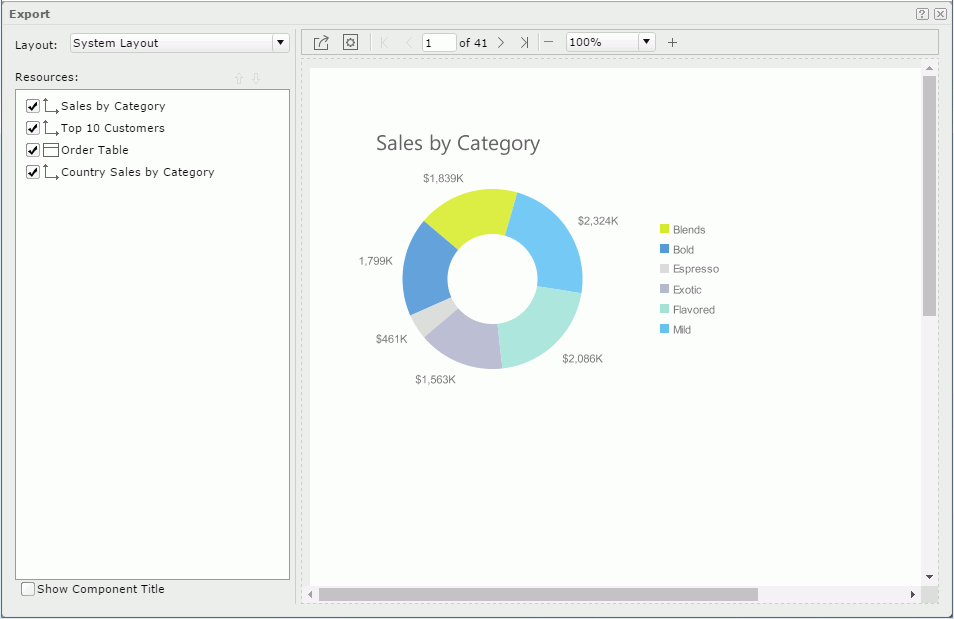
JDashboard displays the preview of the layout in the preview panel on the right. Sometimes you may find that the layout is a little different from what you see in the dashboard.
- In the Resources box, select the library components you want to export. By default all exportable library components are listed and selected.
- The order of the library components in the Resources box determines the order in which they will be exported. You can select
 and
and  to adjust the exporting order.
to adjust the exporting order. - Select the Show Component Title option if you want to show the library component titles in the exported result.
- Select the page navigation buttons on the toolbar of the preview panel to browse the pages if you want.
- Select the Page Setup button
 on the toolbar to set the page properties of the exported result file such as page size and margins in the Page Setup dialog box. You can either define the page properties generally for all export formats or customize the page properties for each export format as you want.
on the toolbar to set the page properties of the exported result file such as page size and margins in the Page Setup dialog box. You can either define the page properties generally for all export formats or customize the page properties for each export format as you want. - Select
 to do the last setting and then export.
to do the last setting and then export.
- From the Export File Format drop-down list, select the format to which the library components will be exported. For a format other than XML, all the selected library components will be exported into one single file. For XML, each library component will be exported to a separate XML file. When the exported result contains more than one file, all the files will be zipped.
- In the File Name text box, specify the name of the exported result file, which could be either a single file or a zipped package name.
- Select Run Linked Report if you need to include linked report in the exported result file.
- Select OK to start exporting.
Exporting Using a Customized Layout
To export using customized layout:
- In the Export dialog box, select Customize Layout from the Layout drop-down list. You can also select an existing customized layout to modify it.

- Select the Show Component Title option if you want to show the library component titles in the exported result.
- Select the Page Setup button
 on the toolbar to set the page properties of the exported result file such as page size and margins in the Page Setup dialog box.
on the toolbar to set the page properties of the exported result file such as page size and margins in the Page Setup dialog box. - In the Design tab, customize the layout of the library components by making use of the following operations.
The library components are arranged using a tabular with each cell holding one component.
- Split or merge cells using the toolbar options:
 ,
,  , and
, and  .
. - Drag a library component from the Resources box into a blank cell in the Design tab. A cell can hold only one library component.
- Delete a library component from a tabular cell using the shortcut menu option Remove.
- For a table or crosstab, only its current view of data as displayed in the dashboard will be exported by default. If you want its full data to be exported, right-click on the table or crosstab and select Filter from the drop-down list. Then in the Filter dialog box, switch from Current View to All and select OK.
- Split or merge cells using the toolbar options:
- Select the View tab to preview the layout. You can browse the pages and zoom in/out by selecting the corresponding toolbar buttons.
If you are satisfied with the layout and want to save it for future use, select
 or
or  on the toolbar, then in the Save As dialog box, provide a name for the layout and select OK. The saved customized layouts will be available in the Layout drop-down list to all users who can access the dashboard. For each of them, you can edit its name or delete it using the two buttons - Rename and Delete - appearing on the right when the mouse hovers over the layout item in the drop-down list.
on the toolbar, then in the Save As dialog box, provide a name for the layout and select OK. The saved customized layouts will be available in the Layout drop-down list to all users who can access the dashboard. For each of them, you can edit its name or delete it using the two buttons - Rename and Delete - appearing on the right when the mouse hovers over the layout item in the drop-down list.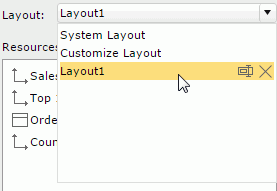
- Select
 , then in the Export dialog box, do the last setting and start exporting.
, then in the Export dialog box, do the last setting and start exporting.
Tip: If you just want to export a single library component, there is a more convenient way.
- Select
 on the component title bar and select Export from the drop-down menu. Report Server displays the Export dialog box.
on the component title bar and select Export from the drop-down menu. Report Server displays the Export dialog box.
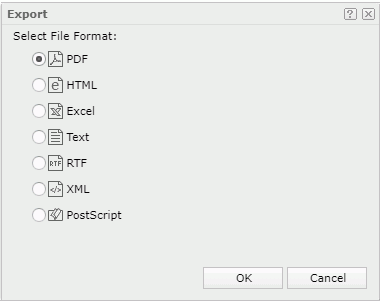
- In the dialog box, choose the format to which you want to export the library component, then select OK.
However, using this way, if the library component is linked with other reports, you cannot control whether to generate the linked reports while exporting. The linked reports will not be included in the exported result.
Printing the Library Components
To print the library components in a dashboard, select the Print button  on the toolbar, or select the Options button
on the toolbar, or select the Options button  on the toolbar and select Print from the option list to open the Print dialog box, then:
on the toolbar and select Print from the option list to open the Print dialog box, then:
To print using system layout:
- In the Print dialog box, select System Layout from the Layout drop-down list.
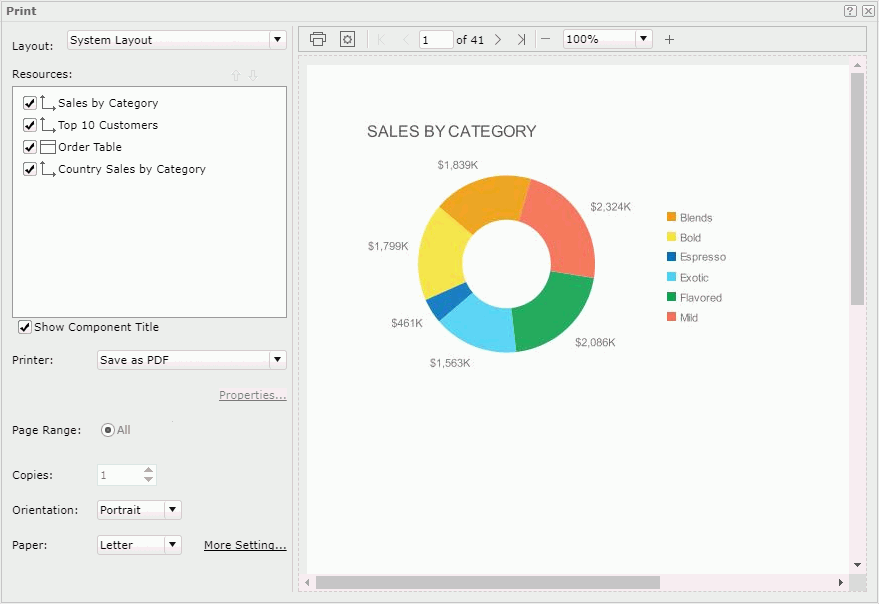
The preview of the layout appears in the preview panel on the right. Sometimes you may find that the layout is a little different from what you see in the dashboard.
- In the Resources box, select the library components you want to print. By default all printable library components are listed and selected.
- The order of the library components in the Resources box determines the order in which they will be printed. You can select
 and
and  to adjust the printing order.
to adjust the printing order. - Select the Show Component Title option if you want to show the library component titles in the printed result.
- From the Printer drop-down list, select the printer to use to print the library component result. All the printers the web browser can access will be listed here. If you want to download the result to a PDF or HTML file and then use your local printer to print the file, select Save as PDF or Save as HTML.
- If a printer is selected, select the Properties link to specify the printing properties in the Printer Properties dialog box.
- Define the number of copies you want to print accordingly.
- Specify the page orientation and paper type for the printed result file. You can select the More Settings link to set more page properties such as paper size and margins in the Page Setup dialog box.
- Select the page navigation buttons on the toolbar of the preview panel to browse the pages if you want.
- Select
 on the toolbar to start printing. If Save as PDF or Save as HTML is selected in the Printer drop-down list, the result file of the library components is then opened in an associated program with which you can print the result to a printer.
on the toolbar to start printing. If Save as PDF or Save as HTML is selected in the Printer drop-down list, the result file of the library components is then opened in an associated program with which you can print the result to a printer.
To print using customized layout:
- In the Print dialog box, select Customize Layout from the Layout drop-down list. You can also select an existing customized layout to modify it.
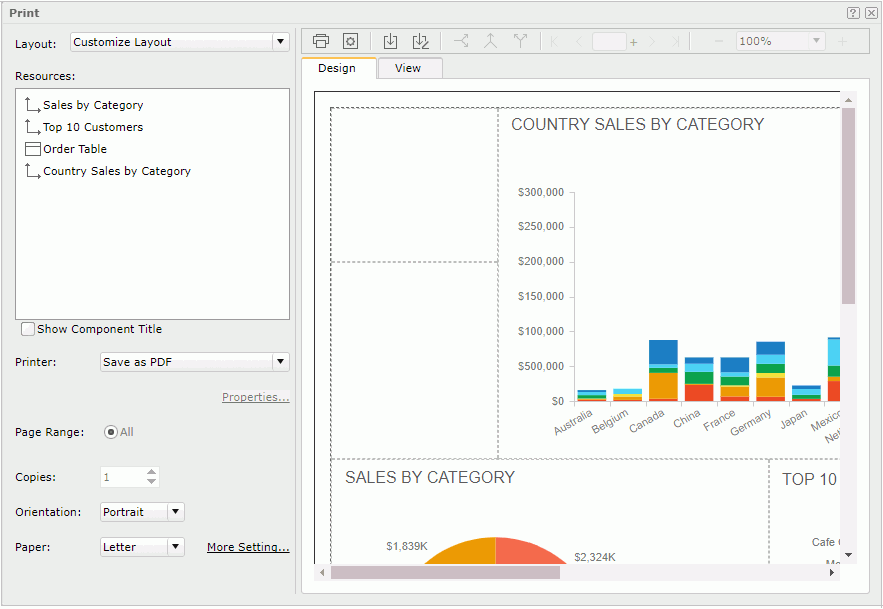
- Do the same as described in steps 4 to 8 of the above system layout procedure.
- In the Design tab, customize the layout of the library components, then preview it in the View tab. For how to customize the layout, see Exporting Using a Customized Layout.
- Select
 on the toolbar to start printing. If Save as PDF or Save as HTML is selected in the Printer drop-down list, the result file of the library components is then opened in an associated program with which you can print the result to a printer.
on the toolbar to start printing. If Save as PDF or Save as HTML is selected in the Printer drop-down list, the result file of the library components is then opened in an associated program with which you can print the result to a printer.
 Previous Topic
Previous Topic